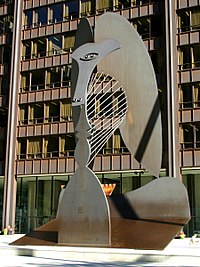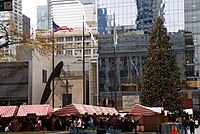Chicago Picasso: Difference between revisions
Andy Dingley (talk | contribs) cat |
Davejenk1ns (talk | contribs) mNo edit summary |
||
| Line 17: | Line 17: | ||
It is known for its inviting [[jungle gym]]-like characteristics.<ref name=Ubepa>{{cite web|url=http://docs.newsbank.com/openurl?ctx_ver=z39.88-2004&rft_id=info:sid/iw.newsbank.com:NewsBank:CTRB&rft_val_format=info:ofi/fmt:kev:mtx:ctx&rft_dat=103E954277686DD4&svc_dat=InfoWeb:aggregated5&req_dat=AA98CDC331574F0ABEAFF732B33DC0B2|title=Unfinished, but engaging, public art - `Cloud Gate' and Crown Fountain intrigue |accessdate=2008-08-06|date=2004-07-18|publisher=Newsbank|work=[[Chicago Tribune]]|author=Artner, Alan G.}}</ref> Visitors to Daley Plaza can often be seen climbing on and sliding down the base of the sculpture. |
It is known for its inviting [[jungle gym]]-like characteristics.<ref name=Ubepa>{{cite web|url=http://docs.newsbank.com/openurl?ctx_ver=z39.88-2004&rft_id=info:sid/iw.newsbank.com:NewsBank:CTRB&rft_val_format=info:ofi/fmt:kev:mtx:ctx&rft_dat=103E954277686DD4&svc_dat=InfoWeb:aggregated5&req_dat=AA98CDC331574F0ABEAFF732B33DC0B2|title=Unfinished, but engaging, public art - `Cloud Gate' and Crown Fountain intrigue |accessdate=2008-08-06|date=2004-07-18|publisher=Newsbank|work=[[Chicago Tribune]]|author=Artner, Alan G.}}</ref> Visitors to Daley Plaza can often be seen climbing on and sliding down the base of the sculpture. |
||
[[Image:Chicago Picasso Maquette.jpg|thumb|125px|left|Maquette on display at the Art Institute of Chicago]] The sculpture was commissioned by the architects of the [[Richard J. Daley Center]] in 1963. The commission was facilitated by the architect William Hartmann of the architectural <ref>http://www.wttw.com/main.taf?p=1,7,1,1,39</ref>firm of [[Skidmore, Owings, and Merrill]]. Picasso completed a [[maquette]] of the sculpture in 1965, and approved a final model of the sculpture in 1966. The cost of constructing the sculpture was $351,959.17, paid mostly by three charitable foundations: the Woods Charitable Fund, the Chauncey and Marion Deering McCormick Foundation, and the Field Foundation of Illinois. Picasso himself was offered payment of $100 |
[[Image:Chicago Picasso Maquette.jpg|thumb|125px|left|Maquette on display at the Art Institute of Chicago]] The sculpture was commissioned by the architects of the [[Richard J. Daley Center]] in 1963. The commission was facilitated by the architect William Hartmann of the architectural <ref>http://www.wttw.com/main.taf?p=1,7,1,1,39</ref>firm of [[Skidmore, Owings, and Merrill]]. Picasso completed a [[maquette]] of the sculpture in 1965, and approved a final model of the sculpture in 1966. The cost of constructing the sculpture was $351,959.17, paid mostly by three charitable foundations: the Woods Charitable Fund, the Chauncey and Marion Deering McCormick Foundation, and the Field Foundation of Illinois. Picasso himself was offered payment of $100,000 but refused, stating that he wanted to make his work a gift.<ref name=LEB>''[[wikisource:Letter Edged in Black Press, Inc. v. Public Building Commission of Chicago|The Letter Edged in Black Press, Inc. v. Public Building Commission of Chicago]]'' 320 F. Supp. 1303 (1970)</ref> |
||
==History== |
==History== |
||
Revision as of 19:42, 3 May 2012
 | |
| Artist | Pablo Picasso |
|---|---|
| Year | 1967 |
| Type | Sculpture |
| Dimensions | 15 m (50 ft) |
| Location | Daley Plaza, Chicago |
The Chicago Picasso (often just The Picasso) is an untitled monumental sculpture by Pablo Picasso in Chicago, Illinois. The sculpture, dedicated on August 15, 1967, in Daley Plaza in the Chicago Loop, is 50 feet (15.2 m) tall and weighs 162 tons.[1] The Cubist sculpture by Picasso was the first such major public artwork in Downtown Chicago, and has become a well known landmark.
It is known for its inviting jungle gym-like characteristics.[2] Visitors to Daley Plaza can often be seen climbing on and sliding down the base of the sculpture.

The sculpture was commissioned by the architects of the Richard J. Daley Center in 1963. The commission was facilitated by the architect William Hartmann of the architectural [3]firm of Skidmore, Owings, and Merrill. Picasso completed a maquette of the sculpture in 1965, and approved a final model of the sculpture in 1966. The cost of constructing the sculpture was $351,959.17, paid mostly by three charitable foundations: the Woods Charitable Fund, the Chauncey and Marion Deering McCormick Foundation, and the Field Foundation of Illinois. Picasso himself was offered payment of $100,000 but refused, stating that he wanted to make his work a gift.[4]
History
The sculpture was fabricated by the American Bridge Company division of the United States Steel Corporation in Gary, Indiana using COR-TEN steel, before being disassembled and relocated to Chicago.[1] Before fabrication of the final steel sculpture was started, a 3.5 meter (~12 feet) tall wooden model was constructed for Picasso to approve, this was eventually sent to the Gary Career Center.[5] Ground was broken in Daley Plaza for the construction of the sculpture on May 25, 1967.[6]
The efforts of the City of Chicago to publicize the sculpture — staging a number of press events before the sculpture was completed, and displaying the maquette without a copyright notice — were cited as evidence in a 1970 U.S. District Court case where the judge ruled that the city's actions had resulted in the sculpture being dedicated to the public domain.[4]
Controversy
The sculpture was initially met with controversy.[7] Before the Picasso sculpture, public sculptural artwork in Chicago was mainly of historical figures.[8] One derisive Chicago City Council alderman immediately proposed replacing it with a statue of Ernie Banks,[9] and Chicago publicist and science fiction writer Algis Budrys erected a giant pickle on the proposed site.[10] There was speculation on the subject, which ranged from a bird, or aardvark to Picasso's pet Afghan Hound, or a baboon head.[11]
Newspaper columnist Mike Royko, covering the unveiling of the sculpture, wrote: “Interesting design, I’m sure. But the fact is, it has a long stupid face and looks like some giant insect that is about to eat a smaller, weaker insect.” Royko did credit Picasso with understanding the soul of Chicago. “Its eyes are like the eyes of every slum owner who made a buck off the small and weak. And of every building inspector who took a wad from a slum owner to make it all possible.... You’d think he’d been riding the L all his life.” [12]

Artist Intent
Although Picasso never explained what the sculpture was intended to represent,[13] it may have been inspired by a French woman, Sylvette David, now known as Lydia Corbett, who posed for Picasso in 1954. Then 19 years old and living in Vallauris, France, Corbett would accompany her artist boyfriend as he delivered chairs made of metal, wood and rope. One of those deliveries was to Picasso, who was struck by her high ponytail and long neck. "He made many portraits of her. At the time, most people thought he was drawing the actress Brigitte Bardot. But in fact, he was inspired by [Corbett]," Picasso's grandson Olivier Widmaier Picasso told the Chicago Sun-Times in 2004.
"I think the Chicago Sculpture was inspired by her," said the grandson, author of Picasso, the Real Family Story. Picasso made 40 works inspired by her, said the grandson, including The Girl Who Said No, reflecting their platonic relationship. The quality of the Picasso's sculpture inspired other artists such as Alexander Calder, Marc Chagall, Joan Miró, Claes Oldenburg and Henry Moore. Acceptance from these artists influenced the acceptance from Chicagoans. As many other sculptures and architecture in Chicago, the Picasso became a symbol of the city.
Local and pop culture
It was mentioned (and appears) in the 1980 film The Blues Brothers during the chase scene leading to the Richard J. Daley Center, and can also be seen briefly in the 1993 film The Fugitive, as Kimble (and then his pursuers) run across the plaza.
Today, the Chicago Picasso has become a well known meeting spot for Chicagoans. Depending on the season and time of the month there are musical performances, farmer's markets, a Christkindlmarkt, and other Chicago affairs are held around the Picasso statue in front of Daley Plaza.

Notes
- ^ a b 1967 August 15--Picasso Statue Unveiled In Civic Center Plaza. Chicago Public Library (URL accessed 14 August 2005).
- ^ Artner, Alan G. (2004-07-18). "Unfinished, but engaging, public art - `Cloud Gate' and Crown Fountain intrigue". Chicago Tribune. Newsbank. Retrieved 2008-08-06.
- ^ http://www.wttw.com/main.taf?p=1,7,1,1,39
- ^ a b The Letter Edged in Black Press, Inc. v. Public Building Commission of Chicago 320 F. Supp. 1303 (1970)
- ^ Davich, Jerry (January 5, 2006). "Unveiling Picasso's steel city beginnings". The Times of Northwest Indiana. Lee Enterprises. Retrieved 2007-08-27.
- ^ Barry, Edward (May 26, 1967). "Break Ground for Big Statue in Civic Center". Chicago Tribune. Tribune Company.
- ^ "Artropolis". Merchandise Mart Properties, Inc. 2007. Retrieved 2007-06-06.
- ^ http://www.wttw.com/main.taf?p=1,7,1,1,39
- ^ "An Old Maestro's Magic". Time Magazine. Time Inc. 1967-08-25. Retrieved 2007-06-06.
- ^ Zeldes, Leah A. (2010-07-26). "The Picasso put Chicago in a pickle". Dining Chicago. Chicago's Restaurant & Entertainment Guide, Inc. Retrieved 2010-08-01.
- ^ "Pablo Picasso - Other Works - Art Gallery Svetlana & Lubos Jelinek". Retrieved 2007-11-08.
- ^ Persky, Mort. "Inch by Column Inch". Los Angeles Review of Books. Retrieved 14 March 2012.
- ^ Virginia Soto. Chicago Picasso. About.com (URL accessed 14 August 2006).
References
- Herrmann, Andrew, "The Woman Who Inspired City's Picasso", Chicago Sun-Times (Nov. 11, 2004)
- Artner, Alan G., "Chicago's Picasso sculpture: The unveiling of the puzzling sculpture changes the public art landscape". Chicago Tribune (Aug. 15, 1967)
